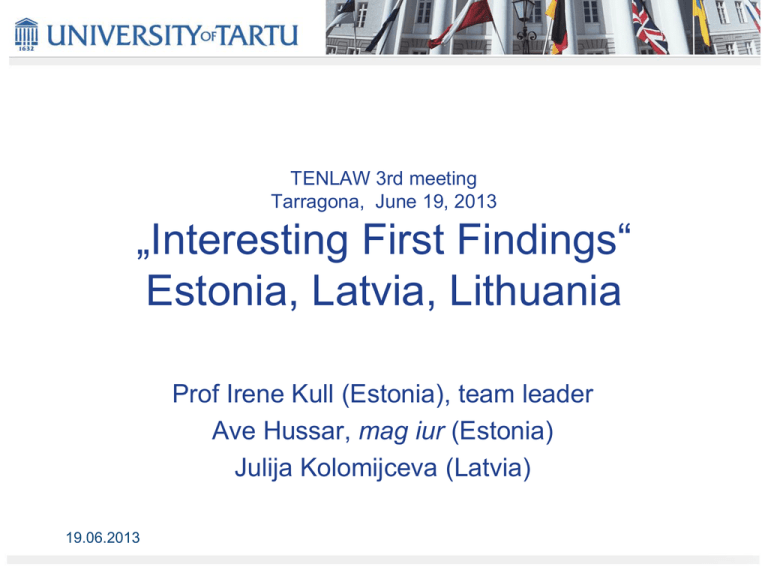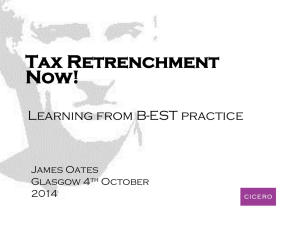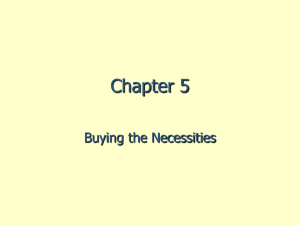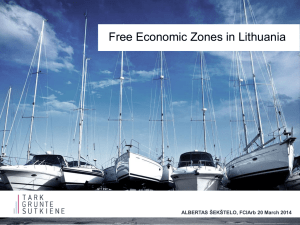Estonia/Latvia/Lithuania Team Presentation
advertisement

TENLAW 3rd meeting Tarragona, June 19, 2013 „Interesting First Findings“ Estonia, Latvia, Lithuania Prof Irene Kull (Estonia), team leader Ave Hussar, mag iur (Estonia) Julija Kolomijceva (Latvia) 19.06.2013 Plan 1. Socio-economic context of tenancy relations 2. Legal environment of tenancy relations 3. Evaluation of first interesting findings 19.06.2013 2 1.1. Common inheritance • Intensive apartment building 1960-1980 • Limited private ownership of (small) residential houses • By 1990 - number of dwellings per 1000 inhabitants EE- 412, LV – 369, LT – 312 (source: Kährik, Kõre 1996) • Still shortage 5 % by 1989 (Estonia) 19.06.2013 3 1.2. Choices since 1991 • Tenants of restituted houses – Estonia: regulated rent periods (until 2007), rent control (until 2004), social housing options; 3 % of the population. – Latvia: split property problem→compulsory lease of land; problematic rent control. (In 2006 the Constitutional Court declared rent payment restrictions in relation to tenancy of house denationalised or returned to a lawful owner as unconformable with the Constitution.) – Lithuania: In 1991–2010, the number of tenant families evicted amounted to 7,1 thousand - 46 % per cent of them were accommodated in the dwellings provided by municipalities, 54 % found other solutions (land plots to build individual residential houses were granted etc.). 19.06.2013 4 1.2. Choices since 1991 • Privatised ownership – Estonia: mainly flats, mainly non-Estonians families – Latvia: privatisation and denationalisation - split propery problem – Lithuania: Most housing property eligible for privatization had been privatized by the end of 1993. Result: private ownership of dwellings – more than 90% of the dwelling stock 19.06.2013 5 1.3.1. Structure and condition of housing stock Number of dwellings per 1000 inhabitants Source: http://www.housingeurope.eu/www.housingeurope.eu/uploads/file_/HER%202012%20EN%20w eb2_1.pdf; Statistics Estonia EE - 505 (2011) LV – 461 (2009) LT – 400 (2011) 19.06.2013 6 1.3.1. Structure and condition of housing stock Useful floor area of dwellings per capita, in sq m (1999-2011) Source: National statistics, http://www.seb.ee/sites/default/files/web/files/uudised/baltic_household_outlook_oct_2012.pdf EE - 30,1 m2 (2011) LV – 27,2 m2 (2009) LT – 25,5 m2 (2011) EU – ca 40 m2 19.06.2013 7 1.3.1. Structure and condition of housing stock Distribution of population by dwelling type, 2011 Source: Eurostat (online data code: ilc_lvho01) Live in flats: EE - 64,5 % LV – 65,4 % LT – 57 % EU – 41,8 % 19.06.2013 8 1.3.1. Structure and condition of housing stock Condition of housing stock, 2011 Source: Eurostat (online data code: ilc_lvho01) Overcrowding rate (% of total population) EE – 14,4 LV – 44,4 LT – 19,7 EU – 16,9 Severe housing deprivation rate (% of total population) EE – 4,9 LV – 17,9 LT – 7,7 EU – 5,5 19.06.2013 9 1.3.2. Market share of different types of tenure, 2011 Source: Eurostat (online data code: ilc_lvho02) http://www.seb.ee/sites/default/files/web/files/uudised/baltic_household_outlook_oct_2012.pdf Owner occupied (% of the population): EE – 85,5 % LV – 84,1 % LT – 93,1 % EU – 70,7 % Private ownership of housing stock (% of housing stock): EE – 97 % LV – 97 % LT – 89 % 19.06.2013 10 1.3.2. Market share of different types of tenure, 2011 Summary: ownership and tenure structure • Estonia – Ownership structure of dwelling stock (2011): 95.7% residents of Estonia or foreign country, 1.8% by state or local government. – 64,5 % of the population live in flats – Estimated rental market 4 -15 % (of which ¼ social housing) – There is no general housing shortage - only 83.9% occupied . – Considerably large part of the households (13 %) lack elementary sanitary conditions . • Latvia: Approx. 84.9% of the whole the housing stock is in owneroccupied and 15.1 % are rental dwellings. 65,4 % live in flats (highest ratio in EU!) • Lithuania the official housing rental market almost does not exist. Private housing sector accounted for 97% (2001) of the total housing stock, rest - social housing. Estimated share of people living in rented dwellings is about 12 percent and 88 percent own a house or a flat where they live. 19.06.2013 11 1.4. Influencing factors 1.4.1. Economic factors Household expenditure: Estonia (2010) - 19 % Latvia (2011) - 16,6 % Lithuania (2009) – 15,9 % EU 27 (2009) – 22,9 % Ratio of private loans to GDP: Estonia: 44 %; Latvia: 37 %; Lithuania: 25 %. Nordic pattern: proportion of housing loans in the overall portfolios: EE - 84 %, LV - 81 %, LT - 79 %. 19.06.2013 http://www.seb.ee/en/news/2012-1023/household-debt-burden-lower-balticrepublics-nordic-countries 12 1.4. Influencing factors 1.4.1. Economic factors • „The sharpest drop in real terms occurred in Greece, where the median equivalised disposable income fell by 12.3 %. It fell by 6.6 % in Bulgaria, 6.1 % in Latvia, 5.8 % in Spain, 4.8 % in Estonia and 4.4 % in Portugal“. (Source: Economy and finance. Statistics in focus 2/2013 http://epp.eurostat.ec.europa.eu/cache/ITY_OFFPUB/KS-SF-13002/EN/KS-SF-13-002-EN.PDF) • Market slowly recovering • Average interest rate of housing loans low (June 2012): EE - 2,9 % p.a, LV – 3,22 % p.a., LT - 3,5 % p.a. • City centre residental investent yield – ca 4-5 % 19.06.2013 13 1.4. Influencing factors 1.4.2. Urban and social factors • „Eastern Member States generally spent a higher than average proportion on food and non-alcoholic beverages. Indeed, this share is largest in Latvia and Estonia, with 20%, /…/. On the other hand, the combined share of actual and imputed housing rentals is generally lower in these countries, ranging from 7 % in Poland to 15 % in the Czech Republic“(Economy and finance. Statistics in focus 2/2013 http://epp.eurostat.ec.europa.eu/cache/ITY_OFFPUB/KS-SF-13-002/EN/KS-SF-13-002-EN.PDF) • • Lithuania: ca 60 percent of those who rented the apartment, live in the biggest cities of Lithuania. The lease is preferred by 18-35 years old people, who have not yet developed their family, who have lower-than-average. The market supply of rental housing is sufficient. Number of social housing and municipality owned shelters are not sufficient. Dwelling lease is assessed like a temporary solution until own housing acquisition. Estonia: While only in 1998 did 30.2% of the employed rural population work in cities and 62% worked in the municipality of their residence, the respective figures for 2004 were 38.5% and 50.7% . 19.06.2013 14 1.4. Influencing factors 1.4.3. Housing policy • • • • • Estonia: Social Welfare Act art 14, Constitution Art 28. The Estonian National Housing Development Plan for 2008-2013. Latvia: The state institution works out and sets goals of housing policy, local municipalities realize housing policy as their exclusive function through assistance in solving residential space matters. Local municipalities are obliged to help inhabitants to solving housing matters. Lithuania: The Law on the Lithuanian state support for housing to purchase or lease and apartment buildings renovation (modernization) set two state support to individuals and families who have a permanent residence in the Republic of Lithuania forms: 1) Municipal social rented housing 2) Support for housing purchase, construction (reconstruction). 19.06.2013 15 1.4. Influencing factors 1.4.4. Migration • • • • Migration: first to east, then to west... Estonia: negative – minus 5,5% (2000-2011) Latvia: negative - 30 thousand against 7,2 thousand (2011). Lithuania: negative - 222 thousand against 45,3 thousand immigrated. In the context of other EU member states, Lithuania is distinguished by the largest negative net migration per 1000 population. 19.06.2013 16 1.4. Influencing factors 1.4.5.Taxation • • • ESTONIA: problems connected with personal income tax (21 %): – Landlord as a regular taxpayer has no possibility of deducting any expenses from taxable income → official renting not attractive – Landlord as a sole proprietor has an obligation to pay social tax from the rental payments received → official renting not attractive LATVIA: black market problems and tax evasion – Landlord registered as self-employed person in the State Revenue Service may deduct management expenses and other expenses connected with economical activity from taxable income, including, but not limited to social tax payments. Personal income tax amounts to 24%. – Landlord may not register as self employed person, then only immovable tax may be deducted. The tax rate is 10% in these cases. LITHUANIA: The dwelling's owner must pay taxes from the rent income received so the people do not conclude rent contracts and the lessees can not register the place as their permanent place of residence. Income tax rate is 15 % 19.06.2013 17 2. Legal environment 2.1. General structure of legal framework • • • Estonia: Law of Obligations Act (2002), Part 3 Contracts for Use, Chapter 15 Lease Contracts Art.-s 271-338 Latvia: Law on Residential Tenancy (1993, as lex specialis),Civil Law (adopted 1937, restored 1991), Law on Social Apartments (1997), Law on Assistance in Solving Apartment Matters (2004) Lithuania: Civil Code (2000) Book Six Part Four Chapter XXXI Lease of dwellings. General rules regulating the rent contract are applicable in so far as the special rules of the dwelling’s rent contract do not establish the special regulation. 19.06.2013 18 2.2. Selected topical legal issues 2.2.1. Degree of freedom of contract • Estonia: – – • Latvia: – – • Partly mandatory (for lessor) rules regarding the rights, obligations and liability of the parties to a residential lease (Art. 275 of the LOA) – not applicable for social rental contracts! Special rules for residential lease, e.g. limited right of termination, formal requirements of termination, contestation of termination, limits to agreement of periodical increase in rent of dwelling. Tenancy law is liberal and many questions shall be regulated by a mutual agreement of parties. High degree of freedom of contract, but not absolute, mandatory provisions are connected with payments for basic services (heating, cold water, sewerage, garbage disposal), termination of rent by the landlord, eviction of the tenant etc. Lithuania: – – The majority of rules which are set in the Civil Code for the tenancy regulation are nonmandatory. the Civil Code establishes some mandatory rules concerning conditions of the rent contract. 19.06.2013 19 2.2. Selected topical legal issues 2.2.2. Formalities ESTONIA LATVIA LITHUANIA Form requirements NO Art 274 of LOA Effect of format of residential lease contract on term of contract (= BGB § 550) YES Article 5 Para.1 of the Law on Residential Tenancy determines that living dwelling rent contracts shall be concluded in writing. However, court practice recognizes factual rental relations. YES/NO Art 6.579 of the CC contracts of lease between natural persons may be formed orally. Only in written form: (i) in the event where the lessor is the state, municipality or a legal person; (ii) a fixed-term contract of lease of a dwelling irrespective of who is the lessor. Registration requirements NO, but: (2) A notation entered in the land register ensures that the new owner has no right to cancel the contract. Without notation the contract will also go over but the new owner has a right to cancel the contract on the ground of own urgent needs. NO, rent contracts are not registered. If a landlord changes then all residential rent contracts concluded by the former owner are binding for the new owner. NO, but: a contract of lease of a dwelling may be invoked against third persons only in the event of it being registered in the Public Register 19.06.2013 20 2.2. Selected topical legal issues 2.2.3. Duration and termination of contract Duration ESTONIA LATVIA LIHTUANIA No restrictions No restrictions : If contract with a term exceeding one year is not entered into in writing, the contract is deemed to have been entered into for an unspecified term with limitation not to be terminated earlier than 1 year after the transfer of the dwelling to the lessee. Parties may enter the rent contract for a specific period of time or without indicating the duration of the agreement A contract of lease of a dwelling may be formed for an indeterminate term or for a fixed term. Either party may cancel a lease contract entered into for longer than 30 years after thirty years, unless the lease contract is entered into for the life of the lessor 19.06.2013 or lessee. There is no mandatory minimum duration for limited in time contracts, but there is mandatory maximum duration – in all cases the period of lease may not exceed 100 years. 21 2.2. Selected topical legal issues 2.2.3. Duration and termination of contract Termination of contract by lessor (renter) 19.06.2013 ESTONIA LATVIA LIHTUANIA 1) open-ended contracts: ordinary cancellation in 3 month notice; 2) fixed-term contracts: only extraordinary cancellation with „good reason“ + some exemple grounds, .e.g: breach of contract by tenant; (immiediate) notice in a format which can be reproduced in writing; contestation of cancellation by lessee within 30 days Only on the basis of the grounds set by law, for example, essential breach of the rent contract; demolition of the living house; owner of denationalized living dwelling needs it for living; unlawful sub-rent. Termination proceeding depends on termination ground. 1) open-ended contracts: notice 6 months in advance 2) In the cases when the lessee breaches the contract the lessor can terminate the contract only by the court decision (after written warning and Nachfrist). Eviction without other dwelling being provided. 22 2.2. Selected topical legal issues 2.2.4. Rent control ESTONIA LATVIA LITHUANIA NO fixed rent. NO fixed rent. YES/NO Control by courts or lease committee for excessiveness of the rent amount (special regulation for residental lease contracts). Possible also control under the general civil law concepts (illegality and immorality rules) Courts control whether management expenses are justified and profit is reasonable. Basis – tenancy law, also general Civil Law (good faith, usury, violation of bonos mores, unconscionability; fairness control in standard terms in consumer law etc. Theoretical limit of maximal amount of lease payable for dwellings leased out on commercial grounds by enterprises, offices, organizations and legal persons. Othewise – NO fixed rate. Reasonability control by courts. 19.06.2013 23 3. Evaluation • High private ownership of housing stock • High owner-occupation and almost non-existent rental market • People prefer having their own dwellings rather than living in a rented house • Dwelling stock in comparatvely bad condition (lack of elementary sanitary conditions) • Low (but growing!) housing expenditure • No general shortage, regional diversities (cities vs rural areas), concentration in Tallinn (Estonia) • Shortage in social housing (competition between municipalities) • Not only privatization and restitution, but also migration • No considerable differences in regulation (generally liberal approach) 19.06.2013 24










